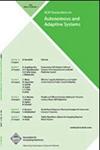Best ACM SAC Articles on Coordination and Self-Adaptation
IF 2.2
4区 计算机科学
Q3 COMPUTER SCIENCE, ARTIFICIAL INTELLIGENCE
引用次数: 0
Abstract
The continuous evolution of information and communication technology (ICT) systems opens a broad range of potential applications in domains such as smart environments, transportation, and energy management. However, it also brings a dramatic increase in complexity: the envisioned ICT systems run in highly dynamic socio-technico-physical environments, often composed of thousands or even millions of connected heterogeneous components, including social networks, web services, mobile computational devices , data centers, and environmental sensors. Traditional centralized approaches hardly deal with those new requirements, especially as far as robustness, resiliency, and complexity are concerned. Rather, computation needs to be carried out in a fully distributed way, and each computational component needs to be autonomous, adaptive, able to perceive contextual information from its environment, and able to collaborate with other components to coordinate emerging complex behaviors. Coordination models and languages, traditionally introduced to tackle interactions in complex systems by suitably designed abstractions such as shared spaces and channels , play a key role in such future and emerging ICT systems. A coordination model simplifies the integration of heterogeneous components (processes, objects, agents, services) and makes the resulting ensemble more smoothly executed as a whole, forming a distributed software system with desired characteristics and functionalities. More specifically, due to the clear separation between computation and interaction they promote , coordination models provide a natural support for injecting self-adaption and self-organization into applications, allowing one to achieve very complex and robust behaviors in terms of a coherent and simple set of coordination rules and mechanisms. All of this is carried out by means of coordination abstractions, languages, algorithms, mechanisms, and middleware specifically focused on the management of component interactions. The " Coordination Models, languages and applications " (CM) track started in 1998 at the ACM Symposium on Applied Computing (SAC) as one of the main scientific events under the umbrella of Coordination, specifically focused to fill the gap between theory and applications. During the successful series of its 17 editions, we have witnessed the emergence of models, formalisms, and mechanisms supporting distributed systems in a number of application scenarios. Most contributions crosscut a number of contemporary software engineering approaches and fields, attracting researchers from many areas inside ICT systems, such as multiagent systems, embedded systems, mobile computing, and robotics. In particular, the latest editions featured an increasing interest in self-adaptive and self-organizing mechanisms and systems. As a result, we decided to foster the development of coordination models …关于协调和自适应的最佳ACM SAC文章
信息和通信技术(ICT)系统的不断发展在智能环境、交通和能源管理等领域开辟了广泛的潜在应用。然而,它也带来了复杂性的急剧增加:所设想的ICT系统在高度动态的社会技术物理环境中运行,通常由数千甚至数百万个相互连接的异构组件组成,包括社交网络、web服务、移动计算设备、数据中心和环境传感器。传统的集中式方法很难处理这些新需求,特别是在健壮性、弹性和复杂性方面。相反,计算需要以完全分布式的方式进行,每个计算组件需要是自主的、自适应的,能够从其环境中感知上下文信息,并能够与其他组件协作以协调新出现的复杂行为。协调模型和语言,传统上是通过适当设计的抽象(如共享空间和通道)来解决复杂系统中的相互作用,在这种未来和新兴的ICT系统中发挥关键作用。协调模型简化了异构组件(过程、对象、代理、服务)的集成,并使最终的集成作为一个整体更顺利地执行,形成具有所需特征和功能的分布式软件系统。更具体地说,由于它们所促进的计算和交互之间的明确分离,协调模型为将自适应和自组织注入应用程序提供了自然的支持,允许人们根据一组连贯而简单的协调规则和机制实现非常复杂和健壮的行为。所有这些都是通过协调抽象、语言、算法、机制和中间件来实现的,这些中间件特别关注于组件交互的管理。“协调模型,语言和应用”(CM)轨道始于1998年ACM应用计算研讨会(SAC),作为协调伞下的主要科学事件之一,专门致力于填补理论与应用之间的差距。在其17个版本的成功系列中,我们见证了在许多应用程序场景中支持分布式系统的模型、形式化和机制的出现。大多数贡献横切了许多当代软件工程方法和领域,吸引了来自ICT系统内许多领域的研究人员,如多智能体系统、嵌入式系统、移动计算和机器人。特别是,最新版本的特点是对自适应和自组织机制和系统的兴趣日益增加。因此,我们决定促进协调模式的发展……
本文章由计算机程序翻译,如有差异,请以英文原文为准。
求助全文
约1分钟内获得全文
求助全文
来源期刊

ACM Transactions on Autonomous and Adaptive Systems
工程技术-计算机:理论方法
CiteScore
4.80
自引率
7.40%
发文量
9
审稿时长
>12 weeks
期刊介绍:
TAAS addresses research on autonomous and adaptive systems being undertaken by an increasingly interdisciplinary research community -- and provides a common platform under which this work can be published and disseminated. TAAS encourages contributions aimed at supporting the understanding, development, and control of such systems and of their behaviors.
TAAS addresses research on autonomous and adaptive systems being undertaken by an increasingly interdisciplinary research community - and provides a common platform under which this work can be published and disseminated. TAAS encourages contributions aimed at supporting the understanding, development, and control of such systems and of their behaviors. Contributions are expected to be based on sound and innovative theoretical models, algorithms, engineering and programming techniques, infrastructures and systems, or technological and application experiences.
 求助内容:
求助内容: 应助结果提醒方式:
应助结果提醒方式:


